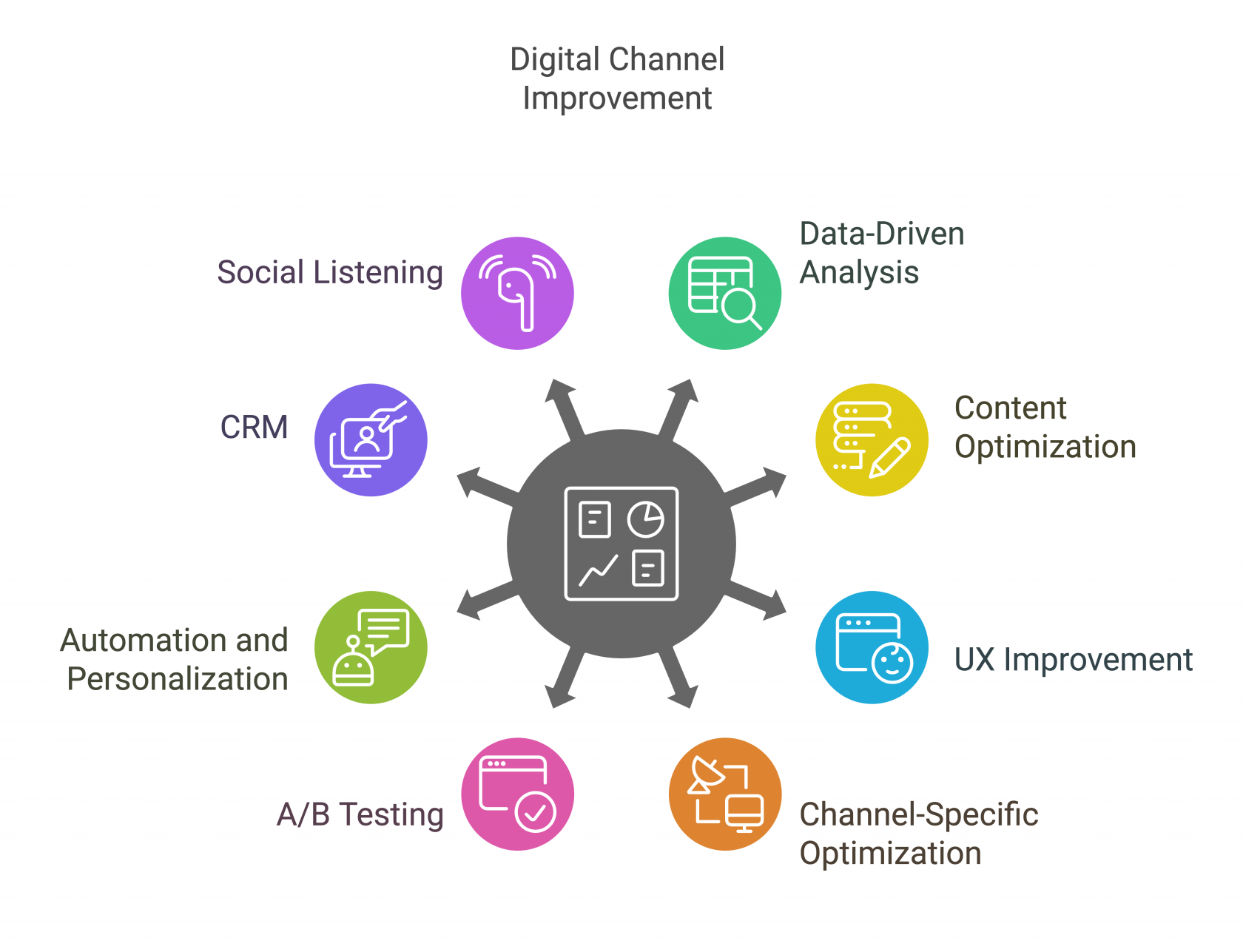Evaluation and improvement of digital channel performance
Improvement of Digital Channel Performance
Improving digital channel performance is crucial for achieving marketing goals and maximizing ROI. It involves a continuous process of analysis, optimization, and experimentation. Here's a breakdown of key strategies:

1. Data-Driven Analysis
- Definition: Using analytics tools to gather and interpret data about channel performance.
-
Points:
- Utilize tools like Google Analytics, social media analytics, and CRM data.
- Track key performance indicators (KPIs) such as website traffic, conversion rates, engagement metrics, and customer acquisition cost (CAC).
- Analyze user behavior to identify patterns and trends.
- Segment data to understand performance variations across different audience groups.
2. Content Optimization
- Definition: Enhancing content to improve its relevance, engagement, and effectiveness.
-
Points:
- Optimize website content for search engines (SEO) by using relevant keywords and improving page speed.
- Create high-quality, engaging content for social media and email marketing.
- Use visuals (images, videos) to enhance content appeal.
- Tailor content to the specific needs and preferences of the target audience.
- A/B test content to determine what performs best.
3. User Experience (UX) Improvement
- Definition: Enhancing the overall experience of users interacting with digital channels.
-
Points:
- Ensure websites and apps are user-friendly and mobile-responsive.
- Simplify navigation and improve site search functionality.
- Optimize landing pages for conversions.
- Reduce page load times.
- Ensure websites and apps are accessible to all users.
4. Channel-Specific Optimization
- Definition: Tailoring optimization strategies to the unique characteristics of each digital channel.
-
Points:
- SEO: Optimize website content, build backlinks, and improve technical SEO.
- SEM: Refine keyword targeting, improve ad copy, and optimize landing pages.
- Social Media: Increase engagement through interactive content, community management, and targeted advertising.
- Email Marketing: Segment audiences, personalize messages, and optimize email deliverability.
- Mobile Marketing: Optimize for mobile devices, use SMS marketing, and leverage in-app advertising.
5. A/B Testing and Experimentation
- Definition: Testing different variations of digital assets to determine which performs best.
-
Points:
- Test different headlines, ad copy, landing page designs, and email subject lines.
- Use A/B testing tools to track results and identify winning variations.
- Continuously experiment and iterate based on data-driven insights.
6. Automation and Personalization
- Definition: Using technology to automate marketing tasks and personalize user experiences.
-
Points:
- Implement marketing automation tools for email marketing, social media scheduling, and lead nurturing.
- Personalize website content and offers based on user behavior and preferences.
- Use dynamic content to deliver targeted messages.
7. Customer Relationship Management (CRM)
- Definition: Using CRM systems to manage and enhance customer relationships.
-
Points:
- Integrate CRM data with other digital marketing tools.
- Use CRM data to personalize marketing messages and offers.
- Track customer interactions across all channels.
- Utilize CRM data to segment audiences.
8. Social Listening and Reputation Management
- Definition: Monitoring social media conversations and managing online reputation.
-
Points:
- Use social listening tools to track brand mentions and industry trends.
- Respond to customer feedback and address negative comments promptly.
- Build a positive online reputation through proactive engagement.
9. Budget Optimization
- Definition: Allocating marketing budget effectively across digital channels.
-
Points:
- Analyze ROI for each channel and adjust budget accordingly.
- Focus on channels that deliver the highest ROI.
- Use data-driven insights to optimize budget allocation.
10. Continuous Improvement
- Definition: Embracing a culture of continuous improvement and adaptation.
-
Points:
- Stay up-to-date with the latest digital marketing trends and technologies.
- Regularly review and update digital marketing strategies.
- Foster a data-driven culture within the organization.

No Comments